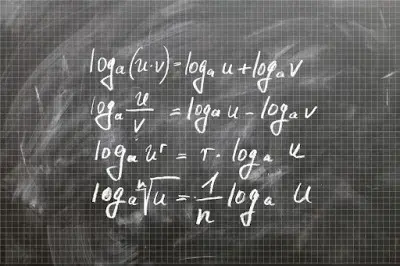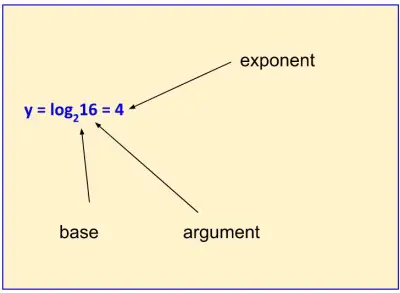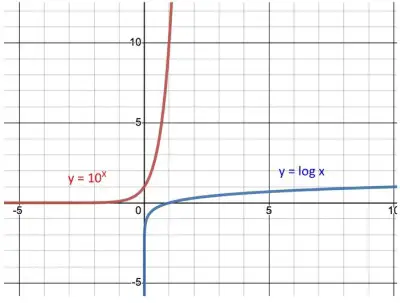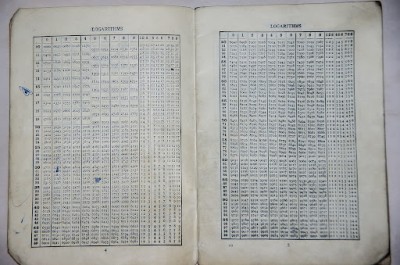If you’re anything like me, you may have bad memories from when you first learned about logarithms. Or, you may dread hearing the word “logs.” Exponential functions, sure, those aren’t too bad. But logarithms? What on earth? They seem so mysterious, right? The reality is, logarithms are useful, interesting, and can even be fun.

In this article, we’ll explore the rules of logarithms. Before we get started, let’s first go over some important information about logarithms. First, it’s helpful to be familiar with the parts of a logarithm:

Now, let’s examine the definition of a logarithm.
The logarithm base b of a positive number a is the exponent to which we raise b in order to get a, where b > 0 and b ≠ 1. In other words:
| logba = x if and only if bx = a |
Recall that logarithmic functions and exponential functions are inverses of one another. For example, the exponential function f(x) = 10x has an inverse function defined as f–1(x) = log10 x.
Essentially, log functions and exponential functions undo each other. It’s important to keep that in mind as we work through problems today. Also, because logs are exponents, they behave in a similar way as exponents.
A few reminders – the common logarithm is the logarithm to base 10. Often, we won’t see 10 as the base; it’s understood to be base 10.
- For example, log(1,000) means “log base 10 of 1,000.”
The natural logarithm is the logarithm to base e where e is the irrational number 2.718…
- So: ln 5 means “log base e of 5.”
Another reminder – log functions are only defined for positive real numbers. If you try typing log 0 into a calculator, it will give you a domain error.
By the definition of logarithms, we know log10 0 = x means, in exponential form, that 10x = 0. So, the value of the logarithm is equal to the number to which we raise 10 in order to output 0.
Consider positive numbers. There is no positive number power that will output 0.
What about raising 10 to the 0 power? Would that work? No, because 100 is defined to be 1.
What about negative numbers? If we raise 10 to a negative number, could that somehow give us 0? No. For example, if we raise 10 to the -1 power, we get:
- 10-1 = 1/10
In fact, raising any positive number to a negative power will output a positive value. Hence, log 0 gives an error.
In a similar manner, the log of a negative value also gives a domain error. It may be helpful to look at the graphs below. Notice that y = log x doesn’t have any x-values that are either 0 or negative.

Working with logs can take some practice. Let’s warm up with a few log problems:
Example 1: Find log2 32
Solution
To find log2 32, we need to ask ourselves, “2 to what power is equal to 32?”. So, we can solve the exponential equation: 2x = 32. If we know anything about powers of 2, it’s pretty easy to see that x = 5.
Example 2: Find log381
Solution
To find log3 81, we need to ask, “3 to what power is equal to 81?” So, we can solve the exponential equation: 3x = 81. In this case, x = 4.
Often when we first start working with logarithms, it’s easier to think in terms of exponents until we get used to working with logs. Logarithms have many properties that are related to exponent rules. In this article, we’re going to explore 8 different log rules.
Recall that with exponents, if we have the same base when multiplying, we add the powers. For example, x5x7 = x5 + 7 = x12. That idea leads us to the first rule.
Rule 1: The Log of a Product
| logb(MN) = logbM + logbN |
In other words, the log of a product is equal to the sum of the log of the factors. This rule comes in handy when we’re solving complicated logarithmic equations. Often, it’s helpful to take a dense log expression and expand it using the laws that we’re learning today.
Example
Expand logb(10x)
Solution
- logb(10x) = logb 10 + logb x ◼
Closely related to the product rule for logs, we also have a rule for quotients.
Rule 2: The Log of a Quotient
| logb(M/N) = logbM – logbN |
Note, both M and N must be positive. The log of a quotient rule is helpful when we’re dealing with logs of fractions. This rule gets used a lot. Let’s look:
Example
Expand and simplify: log2(4/x)
Solution
Using the quotient rule, we get:
- log2(4/x) = log2 4 – log2 x
- = 2 – log2x ◼
This next rule involves the log of a value that’s raised to a power.
Rule 3: The Power Rule
| logb Mn = nlogb M |
When finding the log of a number to a power, we can multiply that power by the log of the number.
Example
Expand: log2(x5)
Solution
- log2x5 = 5log2x ◼
Now let’s look at a special case. You may be on the edge of your seat wondering, “what is the log of 1?” Let’s find out.
Rule 4: Logarithm of 1
| logb 1 = 0 |
Let’s think about this a bit. Using exponents, we need to ask ourselves the question, “b to what power is equal to 1?”
No matter what our base is, the answer is hopefully obvious: 0. Why is that? Because any number raised to the 0 power is defined to be 1. It makes sense therefore that the log of 1 is always 0, no matter what base we use!
What happens if the base matches the argument? For example, what is log10 10? Well, we need to ask ourselves, “10 to what power equals 10?” The answer, of course, is 1. Similarly, log2 2 = 1. This leads us to another rule for logs:
Rule 5: The Identity
| logb b = 1 |
The identity rule comes up a lot – it’s handy to remember that essentially the base and the argument cancel out to 1. So, the following statements are true:
- log33 = 1
- log77 = 1
- ln e = 1
Rule 6: The Log of an Exponent
| logb (b)n = n |
This rule tells us that if the base and the argument match (here, both are equal to b) and the argument is raised to a power, the result is just the power. We can use some of our other rules to prove this.
First apply the power rule:
- logb (b)n = nlogb b
Now, use the identity rule:
- = n1
- = n ◼
And there we have it!
Rule 7: The Exponent of a Log
If you raise a base b to a log power with matching base, the bases cancel out and the result is n.

Rule 8: Change of Base Formula
Back in the old days, most calculators could only compute the natural log of a number or the common log of a number. In fact, many scientific calculators still only have these two bases.
So, it’s helpful to have a formula that helps us change a logarithm to any base we want. Today’s graphing calculators typically have a function that will allow us to input any base.
But, let’s assume we don’t have a graphing calculator. Then we can use the change of base formula:
| logb M = (loga M)/(loga b) |
How does this work? We create a fraction where the log of the numerator and the log of the denominator have the preferred base.
Example 1
You have a big math test today but you forgot your graphing calculator. Fortunately, you have a scientific calculator which will find the common log or the natural log. You need to find log3 21.
Solution
Use the change of base formula. Change log3 21 to base 10 so you can use the “log” button on the scientific calculator.
- log3 21 =(log10 21)/(log10 3)
Now, use the “log” button on your scientific calculator.
- =( 1.3222)/(.4771)
- = 2.771 ◼
Example 2
Write log9 27 with base 3 and simplify.
Solution
- log9 27 = (log3 27)/(log39)
- = 3/2 ◼
Notice in this example that it isn’t easy to think about the original problem, “9 to what power is equal to 27?”It’s obvious that the answer isn’t an integer since 91 = 9 and 92 = 81. Once we converted the problem to base 3, we could easily calculate the logs. Hurray!
Important Note:
Sometimes students confuse the log of a quotient rule with the change of base formula.
Example
On a recent math test, Sarah made this calculation:
- (log510)/(log52) = log510 – log52
Her math teacher Ms. Reynolds, crossed out this calculation. What did Sarah do wrong?
Solution
Sarah incorrectly used the quotient rule for logs instead of recognizing that the change of base rule applies. For the quotient rule, we should only see the word “log” written once: logb(M/N) = logbM – logbN. To correct Sarah’s mistake, she could have applied the Change of Base formula in reverse:
- (log510)/(log52) = log210 ◼
Putting it all together
Now that we have the rules of logarithms, we can use more than one rule at a time.
Example
Solve the equation:
- log(x + 5) + log (x – 2) – log(x) = log 12
Solution
First, notice that we’re using the common log here, that is, base 10. Also, on the left side of the equation, we have addition between the first two terms and subtraction of the last term. We can apply both the product rule and the quotient rule.
- log(x + 5) + log (x – 2) – log(x) = log 12
- log [(x + 5)(x – 2)/x] = log 12
Since both sides of the equation have base 10, we can drop off the logs and set the arguments equal to each other.
- [(x + 5)(x – 2)/x] = 12
Now, this is just a quadratic equation we need to solve.
- (x + 5)(x – 2) = 12x
- x2 + 3x – 10 = 12x
- x2 – 9x – 10 = 0
- (x – 10)(x + 1) = 0
- x = 10, x = -1
Remember, we can’t take the log of a negative number so we need to throw out the value -1 since it produces a negative argument in the original equation.
We should also check the value of 10. Just because it’s a positive number doesn’t mean it’s automatically a solution, because if one of the arguments has subtraction it could still produce a negative. I think we’re good with this solution though. Plug in x = 10 to verify:
- log(x + 5) + log (x – 2) – log(x) = log 12
- log(10 + 5) + log (10 – 2) – log(10) = log 12
Looks great! So x = 10 is a solution. ◼
Example
Expand using the rules of logarithms: log (2xy3)
Solution
First, apply the product rule:
- log (2xy3) = log 2 + log x + log y3
Now, use the power rule on the last term:
- = log 2 + log x + 3 log y ◼
Example
Write as a single logarithm: log x2 – 3log y – log 4
Solution
For this problem, notice that we can use the power rule on the second term.
- log x2 – 3log y – log 4 =
- log x2 – log y3 – log 4 =
The three terms are subtracted so we can use the quotient rule as follows:
- log [x2/(4y3)] ◼
Example
Solve for x:
3000 = 1000 e0.05x
Solution
Notice that the variable x is in the exponent. When we want to solve for a variable that is an exponent, our log rules really help!
- 3000 = 1000 e0.05x
Divide both sides by 1000.
- 3 = e0.05x
Now, take the natural log (ln) of both sides of the equation.
- ln 3 = ln e0.05x
We know from the log of an exponent rule, that ln e0.05x = 0.05x.
Now we have:
- ln 3 = 0.05x
Suddenly, this is a linear equation which is easy to solve! Divide both sides by 0.05.
- x = (ln 3)/(0.05) ◼

Hopefully, this article helped you understand logarithm rules! Remember, math teachers didn’t just invent logs to bother students; logarithms come up in lots of applications like the Richter scale for earthquakes, the pH scale for testing acidity, the Moh’s scale for mineral hardness, decibel scale for sound intensity, and the magnitude scale for star brightness.
(Reference: Robert Coolman, livescience.com)
I hope you found this article helpful. If so, please share it with someone who can use the information.
Don’t forget to subscribe to our YouTube channel & get updates on new math videos!
About the author:
Jean-Marie Gard is an independent math teacher and tutor based in Massachusetts. You can get in touch with Jean-Marie at https://testpreptoday.com/.


